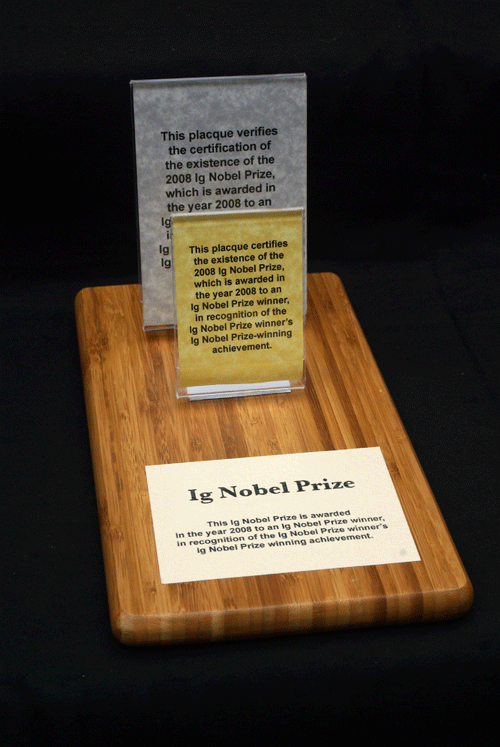
The 2008 Ig Nobel award
By Michael Banks
Maybe physicists are not doing enough research that “first makes people laugh, then think”.
Last night was the annual bash at Harvard University for the Ig Nobel awards, which are given by the humour magazine The Annals of Improbable Research and celebrates research that “cannot, or should not, be repeated”.
Each year the awards have an overall theme. Last year it was redundancy, and in 2007 it was, bizarrely, chickens which involved keynote speaker Doug Zonker repeating the word “chicken” for two minutes.
This year’s theme was risk and mathematician Benoît Mandelbrot gave a keynote address. But fitting in with the eccentricity of the event, every winner of an award had only 60 seconds to give a speech before an eight-year-old girl went up to that stage saying she was ‘bored’.
This year’s ‘physics’ prize went to three anthropologists: Katherine Whitcome from the University of Cincinnati, Daniel Lieberman from Harvard University and Liza Shapiro from the University of Texas won the award for determining why pregnant women do not tip over.
The work, published in Nature, found a difference in the spines of women and men, which allowed a pregnant woman to lean backward and counterbalance the weight of the developing fetus.
I didn’t find the work particularly hilarious and probably represents rather bona fide research.
The chemistry prize lived up more to the suggestion of making you laugh then think. This year’s prize went to Javier Morales, Miguel Apátiga, and Victor M. Castaño at the Universidad Nacional Autónoma de México, for creating diamond films from tequila.
Other 2009 winners include Gideon Gono, governor of Zimbabwe’s Reserve Bank, who won the prize for mathematics for “giving people a simple, everyday way to cope with a wide range of numbers”. Gono ordered bank notes in Zimbabwe to be printed with denominations ranging from one cent to one hundred trillion dollars.
Catherine Douglas and Peter Rowlinson from Newcastle University’s school of agriculture were awarded the veterinary medicine prize for discovering that giving cows names increases their milk yield compared to unnamed cows.
The last few years have seen rather dubious awards given for physics. Last year was for understanding why knots form spontaneously in lengths of “agitated” string, while in 2007 the prize was won for the “physics of wrinkling” — providing insight into why drapes hang a certain way.
It was much better when the prize for physics was given for such things as levitating frogs, calculating that beer froth decays exponentially and finding the best way to dunk a biscuit in a cup of tea.



